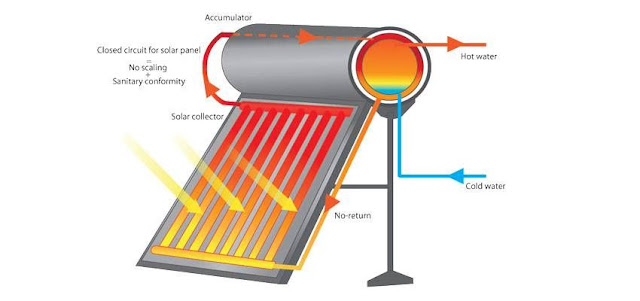Solar Water Heater
Solar water heating
Solar water heating (SWH) is heating water by sunlight, using a solar thermal collector. A variety of configurations is available at varying cost to provide solutions in different climates and latitudes. SWHs are widely used for residential and some industrial applications.
A sun-facing collector heats a working fluid that passes into a storage system for later use. SWH are active (pumped) and passive (convection-driven). They use water only, or both water and a working fluid. They are heated directly or via light-concentrating mirrors. They operate independently or as hybrids with electric or gas heaters. In large-scale installations, mirrors may concentrate sunlight into a smaller collector.
As of 2017, global solar hot water (SHW) thermal capacity is 472 GW and the market is dominated by China, the United States and Turkey. Barbados, Austria, Cyprus, Israel and Greece are the leading countries by capacity per person.
Flat plate
Flat plate collectors are an extension of the idea to place a collector in an 'oven'-like box with glass directly facing the Sun. Most flat plate collectors have two horizontal pipes at the top and bottom, called headers, and many smaller vertical pipes connecting them, called risers. The risers are welded (or similarly connected) to thin absorber fins. Heat-transfer fluid (water or water/antifreeze mix) is pumped from the hot water storage tank or heat exchanger into the collectors' bottom header, and it travels up the risers, collecting heat from the absorber fins, and then exits the collector out of the top header. Serpentine flat plate collectors differ slightly from this "harp" design, and instead use a single pipe that travels up and down the collector. However, since they cannot be properly drained of water, serpentine flat plate collectors cannot be used in drainback systems.
The type of glass used in flat plate collectors is almost always low-iron, tempered glass. Such glass can withstand significant hail without breaking, which is one of the reasons that flat-plate collectors are considered the most durable collector type.
Unglazed or formed collectors are similar to flat-plate collectors, except they are not thermally insulated nor physically protected by a glass panel. Consequently, these types of collectors are much less efficient when water temperature exceeds ambient air temperatures. For pool heating applications, the water to be heated is often colder than the ambient roof temperature, at which point the lack of thermal insulation allows additional heat to be drawn from the surrounding environment.
Evacuated tube
Evacuated tube collectors (ETC) are a way to reduce the heat loss, inherent in flat plates. Since heat loss due to convection cannot cross a vacuum, it forms an efficient isolation mechanism to keep heat inside the collector pipes. Since two flat glass sheets are generally not strong enough to withstand a vacuum, the vacuum is created between two concentric tubes. Typically, the water piping in an ETC is therefore surrounded by two concentric tubes of glass separated by a vacuum that admits heat from the sun (to heat the pipe) but that limits heat loss. The inner tube is coated with a thermal absorber. Vacuum life varies from collector to collector, from 5 years to 15 years.
Flat plate collectors are generally more efficient than ETC in full sunshine conditions. However, the energy output of flat plate collectors is reduced slightly more than ETCs in cloudy or extremely cold conditions. Most ETCs are made out of annealed glass, which is susceptible to hail, failing given roughly golf ball -sized particles. ETCs made from "coke glass," which has a green tint, are stronger and less likely to lose their vacuum, but efficiency is slightly reduced due to reduced transparency. ETCs can gather energy from the sun all day long at low angles due to their tubular shape.




Comments
Post a Comment